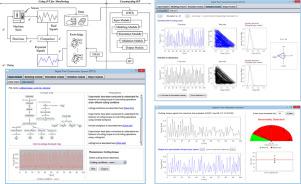Journal of Industrial Information Integration ( IF 15.7 ) Pub Date : 2021-07-06 , DOI: 10.1016/j.jii.2021.100242 Angkush Kumar Ghosh 1 , AMM Sharif Ullah 2 , Roberto Teti 3 , Akihiko Kubo 2

|
Digital twins can assist machine tools in performing their monitoring and troubleshooting tasks autonomously from the context of smart manufacturing. For this, a special type of twin denoted as sensor signal-based twin must be constructed and adapted into the cyber-physical systems. The twin must (1) machine-learn the required knowledge from the historical sensor signal datasets, (2) seamlessly interact with the real-time sensor signals, (3) handle the semantically annotated datasets stored in clouds, and (4) accommodate the data transmission delay. The development of such twins has not yet been studied in detail. This study fills this gap by addressing sensor signal-based digital twin development for intelligent machine tools. Two computerized systems denoted as Digital Twin Construction System (DTCS) and Digital Twin Adaptation System (DTAS) are proposed to construct and adapt the twin, respectively. The modular architectures of the proposed DTCS and DTAS are presented in detail. The real-time responses and delay-related computational arrangements are also elucidated for both systems. The systems are also developed using a Java™-based platform. Milling torque signals are used as an example to demonstrate the efficacy of DTCS and DTAS. This study thus contributes toward the advancement of intelligent machine tools from the context of smart manufacturing.
中文翻译:

为智能机床开发基于传感器信号的数字孪生
数字孪生可以帮助机床在智能制造环境中自主执行监控和故障排除任务。为此,必须构建一种特殊类型的双胞胎,称为基于传感器信号的双胞胎,并将其适应网络物理系统。双胞胎必须 (1) 从历史传感器信号数据集中机器学习所需的知识,(2) 与实时传感器信号无缝交互,(3) 处理存储在云中的语义注释数据集,以及 (4) 适应数据传输延迟。这种双胞胎的发育尚未得到详细研究。这项研究通过解决智能机床的基于传感器信号的数字孪生开发来填补这一空白。提出了两个计算机化系统,称为数字孪生构建系统 (DTCS) 和数字孪生适配系统 (DTAS),分别用于构建和适配孪生。详细介绍了所提出的 DTCS 和 DTAS 的模块化架构。还阐明了两个系统的实时响应和延迟相关的计算安排。这些系统也是使用基于 Java™ 的平台开发的。以铣削扭矩信号为例来说明 DTCS 和 DTAS 的功效。因此,这项研究有助于从智能制造的背景下推动智能机床的发展。还阐明了两个系统的实时响应和延迟相关的计算安排。这些系统也是使用基于 Java™ 的平台开发的。以铣削扭矩信号为例来说明 DTCS 和 DTAS 的功效。因此,这项研究有助于从智能制造的背景下推动智能机床的发展。还阐明了两个系统的实时响应和延迟相关的计算安排。这些系统也是使用基于 Java™ 的平台开发的。以铣削扭矩信号为例来说明 DTCS 和 DTAS 的功效。因此,这项研究有助于从智能制造的背景下推动智能机床的发展。



























 京公网安备 11010802027423号
京公网安备 11010802027423号